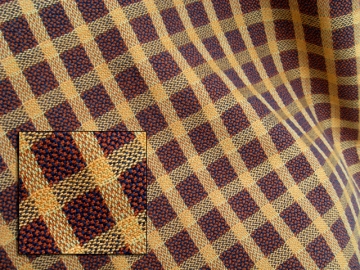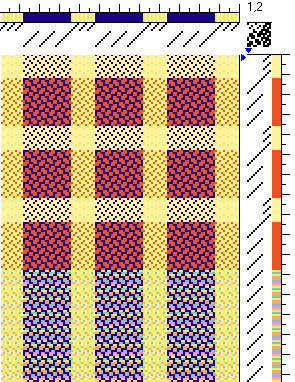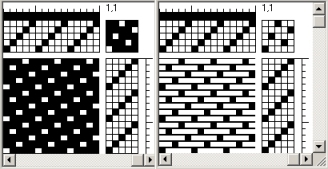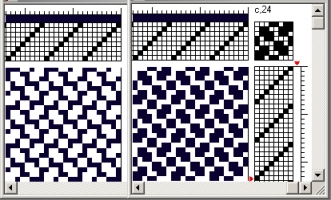William Watson describes crêpe weaves in his 1921 book, Textile Design and Colour, as “…weaves that contain little or no twilled or other prominent effect, and which give a cloth the appearance of being covered by minute spots or seeds. The weaves are used alone and in combination with other weaves in a great variety of cloths….” G. H. Oelsner, in his 1915 book, A Handbook of Weaves, adds that “these are weaves in which the warp and filling are interlaced so as to give the cloth a mixed or uniformly mottled appearance.” Nice, I thought to myself, I want to try this!
Oelsner gives hundreds of examples of crêpe weaves with different effects on various numbers of shafts. I found Watson’s and Oelsner’s books downloadable at handweaving.net as well as crêpe weave drafts from Alice Schlein’s self-published monograph, “A Crepe is Not Just a Pancake.”
I wove a bunch of small samples of crêpe weave, some with Tencel, some cotton, rayon, and even fine silk/merino. Feeling adventurous, I tried combining crêpe weave with satin stripes, recalling having seen something like that when I was a freelance sample weaver in the textile industry years ago.
The final pieces that evolved from my experiments are two different yardages and a scarf.
Crêpe Weave Fabrics with Satin Stripes
In my research I found the description of crêpe weave more straightforward than for satin. One author discussed satin, another discussed sateen, and then I came across the term satinet. So I went to my favorite book for clarification, Irene Emery’s classic, The Primary Structures of Fabrics. I remember a discussion about these different terms a while back on one of the weaving forums. According to Emery, satin would be the term associated with the warp-float face of the satin structure and sateen with the weft-float face. But she goes on to write that sometimes these terms are used ambiguously and it’s clearer if you say warp-satin weave or weft-satin weave to describe the orientation of the structure. She also writes that the term satin is often associated with silk, linen or rayon and sateen with cotton and so sateen is probably most useful as a fabric name rather than a weave structure.
OK, so here are images of the fabrics that I designed and wove, both on the same warp, with drafts and notes:
If you look at the drafts above you will notice that the satin stripes are woven on 4 shafts. According to Oelsner, this is frequently called a satin but strictly speaking it is a broken twill because satin weaves require at least 5 or more shafts. In S. A. Zielinski’s book, Encyclopaedia of Hand-Weaving, satin on 4 shafts is called imitation satin or satinet. So it seems that my satin stripes may be referred to as satinet stripes. Call it what you will, as long as it looks nice!
I used 20/2 dark blue cotton for the crêpe weave part of the warp and 20/2 gold and pale green rayon for the satin stripes part. The wefts used in the first fabric with the squares are 20/2 dark orange cotton and 20/2 gold rayon. The sett is 42 epi and fairly balanced with about 42 ppi. I continued weaving the second fabric with the vertical stripes on the same warp but changed the weft to a variegated colors rayon slub, at about 38 ppi. The fabrics were washed by hand, air dried, and steam ironed. There was a small amount of even shrinkage.
Below is an example of a draft of true satin weave on 5 shafts. As mentioned before, the warp-float face is sometimes referred to as satin and the weft-float face as sateen. The long float spans reflect the luster of a yarn so these weaves are often used with luxurious yarns like silk (or not so luxurious but shiny like rayon that I used in my fabrics). It’s also often woven with the weft-floats on the surface rather than below because less shafts are needed to be raised, and that makes a big difference when weaving satin on many shafts.
Crêpe Weave Scarf
I saved a skein of beautiful, hand-dyed variegated 20/2 Tencel that I bought from Just Our Yarn to weave something special. Crêpe weave seemed like a good choice. Using an 8-shaft crêpe weave, the Tencel warp sett at 45 epi and a 2/64 silk/merino weft at about 48 ppi, I wove a scarf. Same wet finishing as the fabrics. The scarf has a nice drape, the variegated colors in the warp show nicely, and it has an overall iridescent effect.
My next project is already on the loom, something different as my study this year for the Fine Threads Study Group at Complex Weavers. Here’s a preview on my Gallery 2013 page.
Happy Valentine’s Day!








